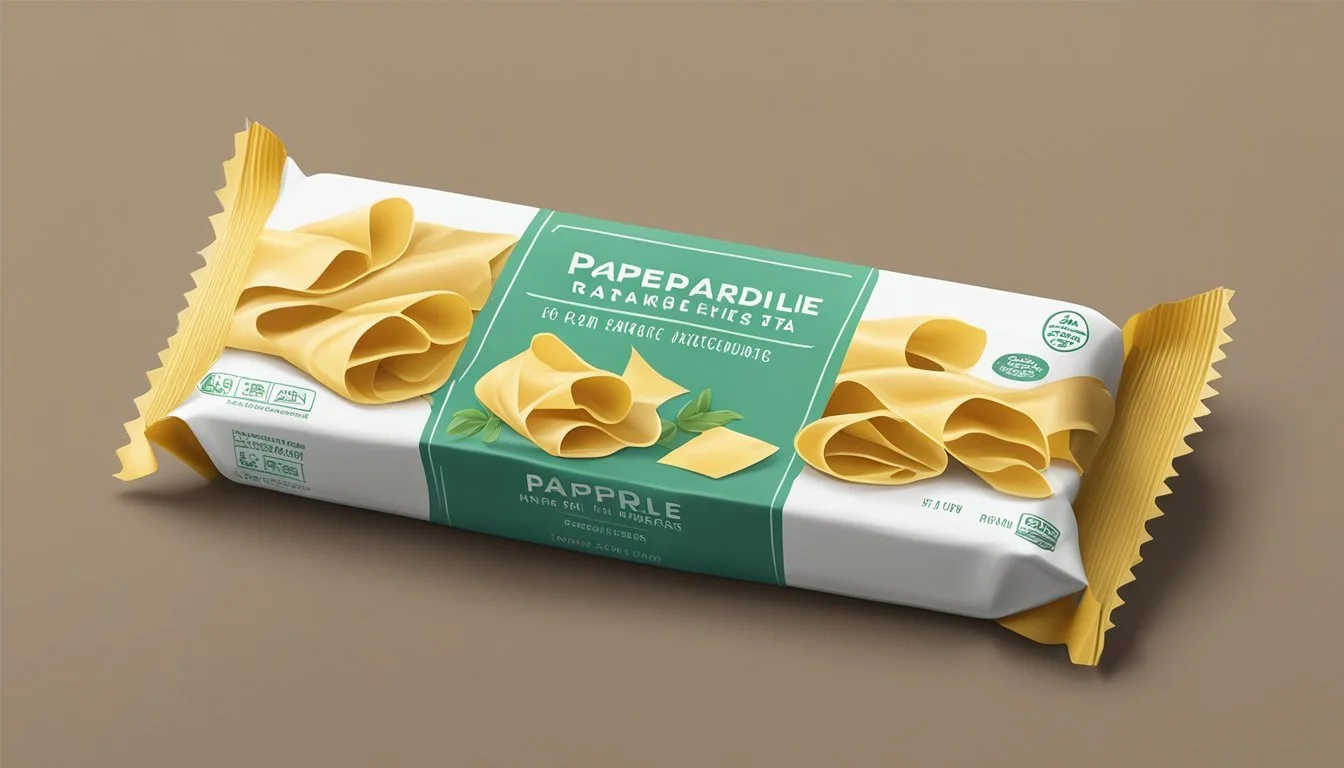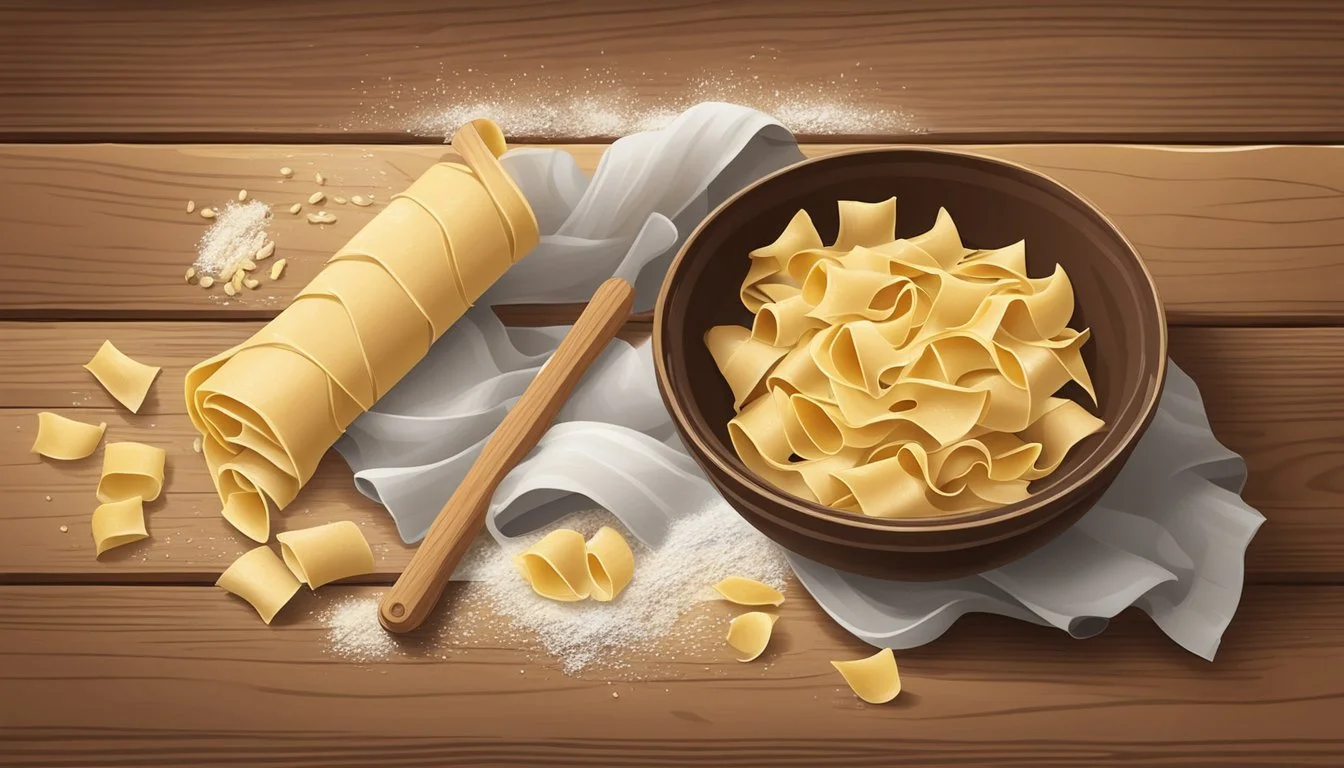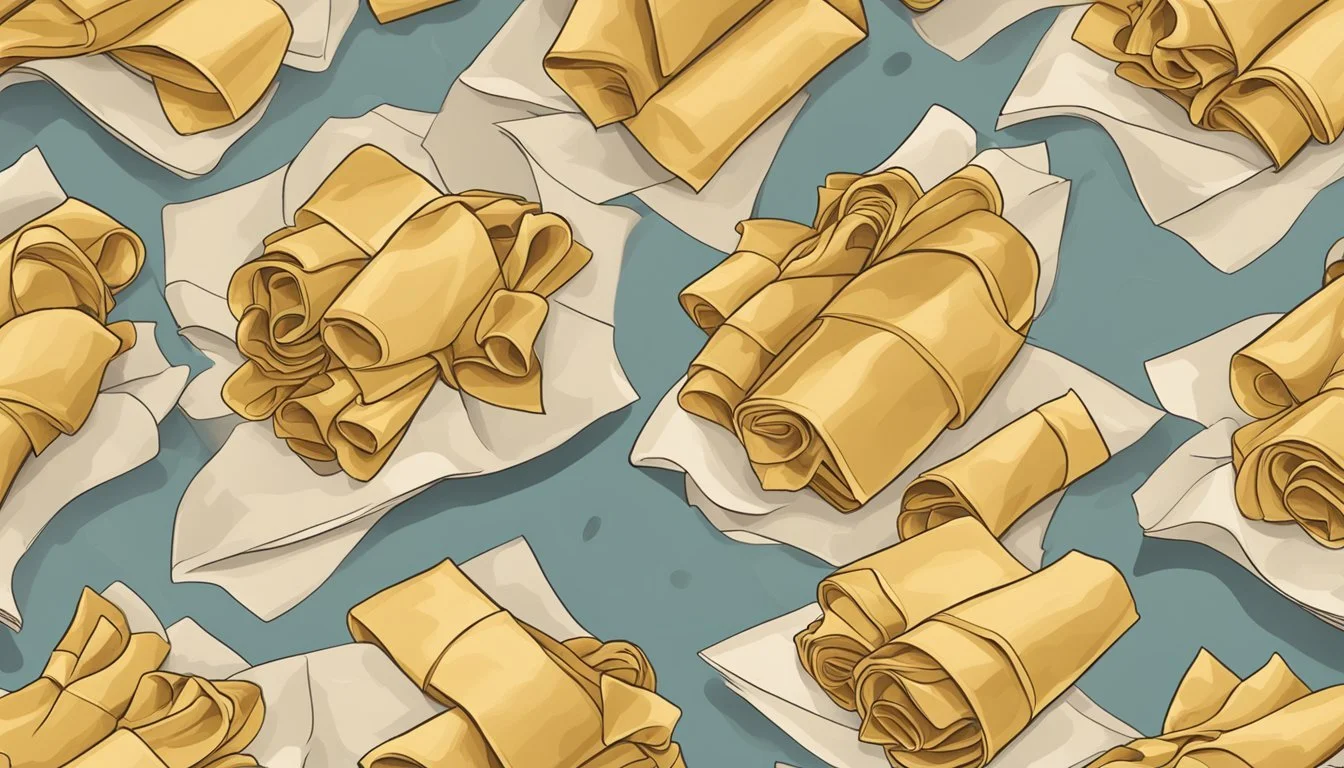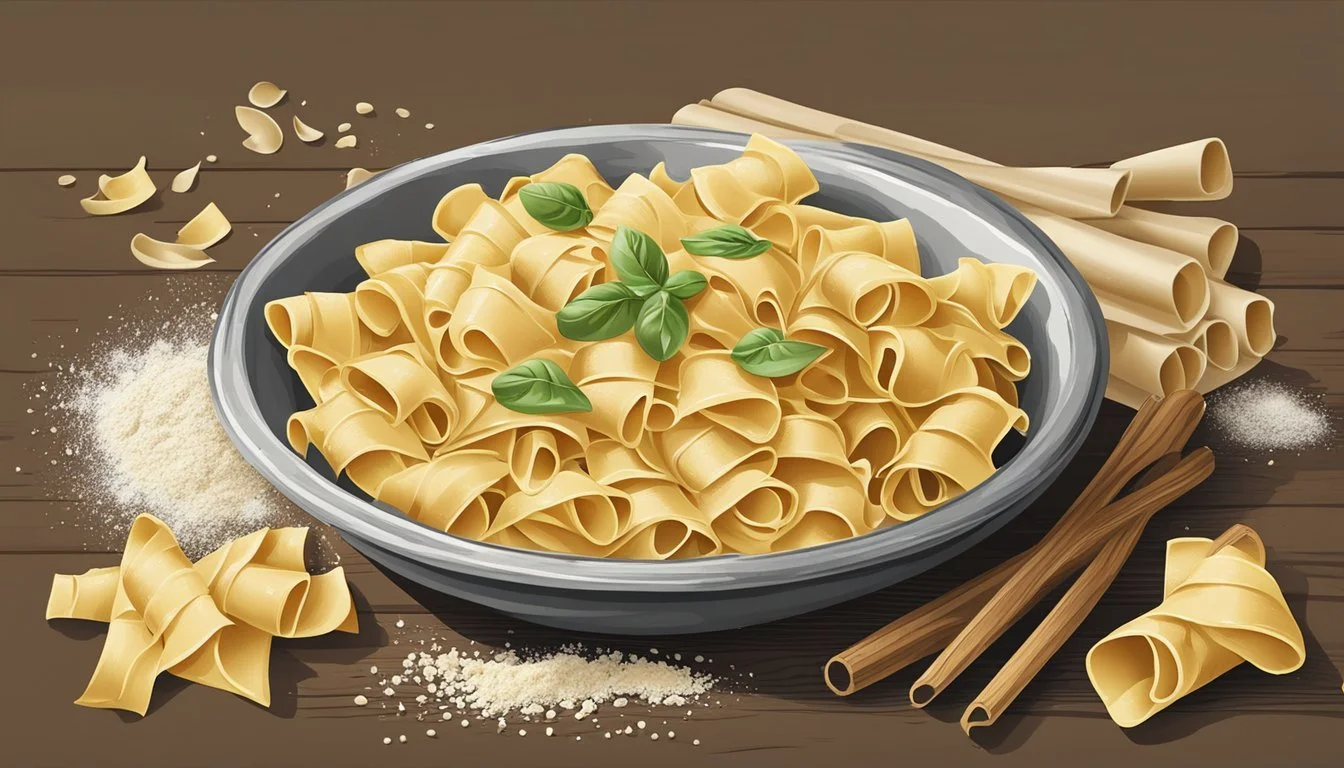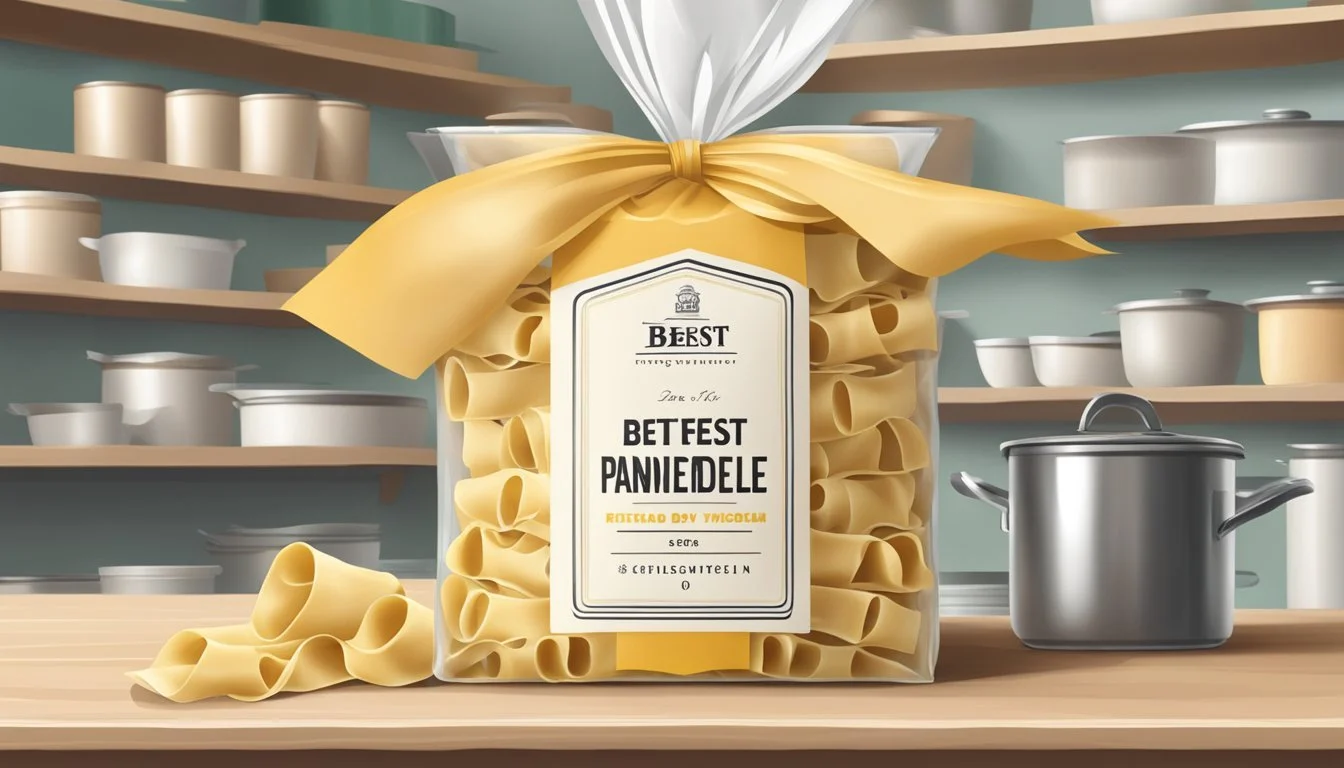How Long Does Pappardelle Pasta Last?
Shelf Life and Storage Tips
Pappardelle pasta is a type of Italian noodle known for its broad, flat ribbons, which pair exceptionally well with rich and hearty sauces. This pasta (What wine goes well with pasta?), originating from Tuscany, is traditionally made with egg-enriched dough, providing a distinct texture and flavor that stands out in Italian cuisine. The shelf life of pappardelle, like other pastas, depends greatly on whether it is fresh or dried. Fresh pappardelle, usually found refrigerated, typically has a shorter lifespan and should be consumed within a few days of purchase, while dried pappardelle can be stored for much longer periods.
Dried pappardelle pasta offers a more extended shelf life, allowing it to be a staple in pantries without the urgent need for consumption. It is best used within 18 months of purchase to enjoy its flavor and quality. However, it is crucial to store it properly in a cool, dry place away from moisture and heat, which can significantly influence its longevity.
When considering how long pappardelle lasts after being cooked, it's essential to store it in an airtight container in the refrigerator and consume it within a reasonable time frame, generally within 3 to 5 days. Understanding these guidelines ensures that the pasta maintains its taste and texture, providing a satisfying Italian dining experience every time it's served.
Pappardelle Pasta Basics
Pappardelle pasta is a type of Italian noodle known for its broad and flat shape. This ribbon-like pasta typically measures about 1 inch (2.5 cm) in width, with some variations being wider. It is often made from a simple dough consisting of flour and eggs, making it rich and slightly chewy when cooked.
The appealing texture of pappardelle is due to its robust surface, perfectly suited for clinging to hearty sauces. Traditionally, recipes for pappardelle come from the region of Tuscany, where they are served with thick, meaty sauces. They have a notable capacity to trap and hold flavors, ensuring each forkful is as satisfying as the last.
Main Ingredients and Preparation:
Flour: A foundational ingredient offering structure.
Eggs: Contribute to the pasta's tender texture and rich flavor.
To make the pasta, these ingredients are blended to form a dough, which is then kneaded until smooth and elastic. After resting, the dough is rolled out and cut into wide ribbons.
Pappardelle recipes often emphasize simplicity, relying on the quality of the pasta itself to stand out. Although these noodles can be purchased dried or fresh, many enthusiasts argue that homemade pappardelle offers an unparalleled culinary experience.
Below is a brief overview of the pasta's attributes:
Attribute Description Shape Wide, ribbon-like Texture Rough, to hold onto sauces Main Uses Sorb robust sauces, often in ragus Cook Time 3-4 minutes for fresh
In terms of shelf-life, dried pappardelle can last for one to two years when stored in a cool, dry place, whereas fresh homemade pappardelle, which contains eggs, typically lasts up to four days in the refrigerator or two months in the freezer.
Cooking Methods
When cooking pappardelle pasta, the goal is to achieve an al dente texture, which means the pasta should be tender but still firm to the bite. One begins by bringing a large pot of boiling water to a rolling boil. It is customary to add a generous amount of salt, creating a salted water environment, which enhances the pasta's flavor as it cooks.
To cook pappardelle, one should carefully add the pasta to the boiling water, ensuring it is fully submerged. The use of a wooden spoon to gently stir the pasta can prevent it from sticking together. The wide, flat shape of pappardelle allows for a hearty sauce adherence, and thus it's essential to maintain its integrity during the cooking process.
Upon returning the water to a gentle boil, it is advisable to continue stirring occasionally. This will aid in an even cooking process and mitigate the risk of the pasta sheets sticking to each other or the bottom of the pot. Pappardelle, due to its thickness, typically has a cooking time of about 7-10 minutes, but this can vary.
Cooking Step Description Boil water Start with 4 quarts of water for every pound of pasta. Add salt Add salt to the boiling water (approximately 1 tablespoon). Add pasta Gently place the pappardelle in the pot, ensuring it's not overcrowded. Stir pasta Stir immediately to prevent sticking, and then occasionally throughout the cooking process. Check doneness Start tasting the pasta a few minutes before the suggested time for desired al dente texture. Drain Once the pasta is cooked, promptly drain it to prevent overcooking.
Consistency is key in achieving the perfect texture. One must remain attentive, checking the pasta often as it nears the latter part of the cooking range to ensure it is perfectly al dente.
Fresh vs. Dried Pappardelle
Fresh and dried pappardelle have different preparation methods, shelf lives, and usage in cooking. The choice between homemade fresh pasta (how long does fresh pasta last?) and store-bought dried pappardelle can influence not only the texture and taste but also the longevity of the product in your pantry or refrigerator.
Making Fresh Pappardelle
To make fresh pappardelle, a combination of eggs, semolina or all-purpose flour, and water is typically needed to form a pliable pasta dough. The dough is then rolled out thin using a rolling pin or a pasta machine and cut into broad, flat ribbons. Freshly made pappardelle should be used relatively quickly after preparation. If it must be stored, it should be placed under plastic wrap in the refrigerator and is best used within a couple of days. The hands-on process of kneading and flattening the dough results in a delicate texture that is often preferred for certain sauces and dishes.
Storing and Using Dried Pappardelle
Dried pappardelle is convenient for longer storage. Typically, dry pappardelle takes about 8 minutes to cook and can be kept for up to 18 months when stored properly in a cool, dry place. One should ensure the packaging is sealed to avoid moisture, which can spoil the pasta. Dried pappardelle's firmer texture holds up well to hearty sauces, making it versatile in a variety of dishes.
Pappardelle Pairings and Sauces
When selecting sauces for pappardelle, hearty sauces are a match made in heaven due to the wide, flat shape of the pasta. The surface area of pappardelle is ideal for thicker, more robust sauces, which cling to the ribbons, ensuring a flavorful bite every time.
Bolognese Sauce is a classic pairing. The meaty texture of a slow-cooked bolognese complements the pasta's broad noodles, capturing the sauce's complexity. For those inclined towards creamier options, a variety of cream sauces can be used to add a velvety cloak to each strand.
Here are some top sauces for pappardelle:
Tomato-Based Sauces: (What wine goes well with tomato-based sauces?) Ranging from a simple garlic and tomato sauce to a spicy Arrabbiata, these sauces coat the pasta evenly and add a bright acidity that balances the richness of pappardelle.
Pesto Sauce (how long does pesto sauce last?): A generous serving of pesto, especially the traditional pesto alla Genovese, brings out the pasta's eggy flavor while providing a herbaceous freshness.
Meat Sauces: Ragù, such as lamb ragù, offers a more substantial option, with tender chunks of meat pairing superbly with the pasta's texture.
For those preferring a minimalist approach, good quality butter melted into the pasta, perhaps with a sprinkle of fresh herbs, can make for a sublime dish.
Sauce Type Recommended Texture Notes Tomato Sauce Arrabbiata Chunky Spicy Cream Sauce Alfredo Smooth Rich Pesto Genovese Coarse Fresh Meat Sauce Bolognese Hearty Slow-cooked richness
Though preferences vary, heavier and textured pasta sauces usually pair best with pappardelle, making each meal memorable and satisfying.
Serving and Presentation
When serving pappardelle pasta, presentation is just as important as the flavor. Pappardelle, characterized by its wide noodle form, offers an ample surface area ideal for clinging to rich sauces. The broad strips, typically made with egg, provide a delightful texture that is both tender and robust.
To maintain the optimal texture, pappardelle should be cooked until al dente and served immediately. Overcooking can lead to loss of the characteristic bite that these noodles are known for. The wide noodle format can be served as long strips or artfully twirled into a nest on the plate, enhancing the visual appeal.
Here is a brief formatting structure for the presentation of pappardelle pasta:
Texture: Aim for al dente to ensure it holds its texture when mixed with sauce.
Form: Serve as:
Long strips to show off the length and width of the pasta.
Twirled nests to create an attractive plate presentation.
Choosing the right sauce is crucial for pappardelle given its wide and flat shape, which pairs well with hearty meat ragus or cream-based sauces. The Italian pasta tradition suggests that the sauce should be complementary in flavor and consistency, avoiding anything too watery that might cause the pasta to clump together or become soggy.
When plated, pappardelle pasta can serve as the centerpiece of a dish. Its elegant appearance is key to the dining experience, and careful attention should be given to ensure each portion is aesthetically pleasing as it is flavorful. Whether it is presented in strips or nests, it makes for a hearty and inviting meal.
Storage and Shelf Life
Proper storage is essential to maintain the quality and extend the shelf life of Pappardelle pasta, whether fresh or dried. Preservation methods differ significantly between fresh Pappardelle, which is more perishable, and dried Pappardelle, with its inherently longer shelf life.
Fresh Pappardelle Storage
Fresh Pappardelle pasta should be kept in the refrigerator to preserve its quality. It is typically best consumed within a few days of purchase. When refrigerating, fresh pasta should be sealed tightly in plastic wrap or an airtight container. If not consumed promptly, it can also be frozen to extend its shelf life. Frozen pasta can last up to 12 months.
Refrigerator: 3-5 days
Freezer: up to 12 months
Dried Pappardelle Preservation
Dry Pappardelle, on the other hand, is noted for its long shelf life. When stored in a cool, dry place in an airtight container, its flavor and freshness can be maintained well beyond its 'best by' date, which is usually set 18 months from the date of purchase. This type of pasta can last for several years under ideal conditions.
Pantry (cool, dry, airtight container): up to several years past 'best by' date
Tips for Perfect Pappardelle
To master the art of crafting exquisite pappardelle, one must consider several factors, from the choice of flour to the meticulousness of kneading and the precision of cooking time.
Choice of Flour:
Semolina flour (how long does semolina flour last?) is the classic choice for authentic, toothsome pasta. It yields a firmer texture and is robust enough to support rich, hearty sauces.
Kneading is Key:
Thorough kneading is essential for developing gluten, which imparts elasticity and chew to the noodles. A well-kneaded dough should have a smooth, resilient texture. One should knead the dough for approximately 10 minutes by hand or with a stand mixer until it's just right.
Rolling Out:
When rolling out the dough, aim for an even thickness to ensure uniform cooking. Pappardelle pasta typically measures around 1 inch (2.5 cm) in width, although some prefer it wider, up to 2 inches (5 cm).
Pasta Type Width Pappardelle 1 - 2 inches Fettuccine approx. 1/4 inch
Cooking Pappardelle:
Use a large pot with plenty of boiling water to prevent the strands from sticking together. Salt the water generously to season the pasta.
Boiling Water:
Gently place the pappardelle in the salted, rolling boil and stir occasionally to maintain separation. The texture should be 'al dente', a term signifying pasta cooked to be firm to the bite.
Cooking Time:
Fresh pappardelle pasta generally requires 4 to 7 minutes to cook, depending on thickness, while dried versions may take a bit longer. Taste test near the end of the cooking duration to achieve the ideal consistency.
Remember, whether one opts for egg noodles (how long do egg noodles last?) or prefers fettuccine's narrower strands, these tips and tricks will serve as their guidepost to perfect pappardelle every time.
Regional Variations and History
Pappardelle pasta has its roots deeply embedded in Italian culinary tradition. As a staple of Italian cuisine, pappardelle is renowned for its broad, flat shape, and it is particularly associated with the region of Tuscany. However, its presence is also notable in surrounding regions such as Emilia-Romagna, where hearty sauces often accompany it.
The name 'pappardelle' is derived from the Italian verb pappare, which means "to gobble up," reflecting the heartiness of the dishes it often creates. The traditional recipe for making homemade Italian pappardelle involves a simple combination of flour and eggs, rolled out to create the wide ribbons that characterize the pasta.
Homemade Italian Pappardelle:
Ingredients: Flour, Eggs
Width: 2-3 centimeters
Texture: Rough to hold sauce
In different Italian locales, variations of the pasta may include the addition of herbs or other flavorings to complement regional sauces and ingredients. While Tuscany favors meaty and intense sauces for pappardelle, regions like Emilia-Romagna may incorporate local specialties such as Bolognese ragù, a slow-cooked meat sauce.
The versatility and adaptability of pappardelle have contributed to its popularity both within Italy and internationally, making it a cherished component of Italian pasta culture. Whether dining in a rustic Tuscan trattoria or a high-end Emilia-Romagna ristorante, one can expect pappardelle to be served with a richness and depth of flavor that showcases Italian culinary artisanship.
Pairing Pappardelle with Meals
When considering pappardelle pasta for a meal, one should contemplate the sauces and ingredients that align with its texture and shape. This wide, ribbon-like pasta is best complemented by hearty and robust sauces.
A classic Bolognese sauce, often made with a combination of veal and pork, clings well to the broad surface of pappardelle, enabling each strand to capture the rich flavors of the meat and tomato-based sauce. Chefs emphasize the importance of simmering the sauce for an extended period, allowing the flavors to meld together, which then soak into the pasta for a delightful taste in every bite.
Mushrooms: Their earthy profile pairs exquisitely with pappardelle. Mushroom ragùs with a base of wild mushrooms, herbs, and cream can elevate the pasta to an entrée that pleases both vegetarians and meat-eaters alike.
Ragus: Pappardelle also serves as a suitable canvas for different types of ragùs, including those made with game meats or slow-cooked beef. The pasta's ample surface area allows more of the sauce and small meat pieces to adhere to it.
For individuals seeking lighter fare, pappardelle can be incorporated into pasta salads. When used in pasta salads, it's recommended to cut it into shorter lengths. This ensures the pasta integrates well with a variety of dressings and salad components like fresh vegetables, olives, and feta.
Pasta Type Sauce/Pairing Notes Pappardelle Bolognese Ideal with meat-based sauces Pappardelle Mushroom Ragù A vegetarian-friendly option Pappardelle Game Meat Ragùs Complements the texture of the pasta Pappardelle Pasta Salads Cut into shorter lengths for best results
The versatility of pappardelle makes it an excellent choice for a wide range of meals, from the hearty winter dish to the light summer pasta salad.
Pappardelle in Professional Cooking
In the realm of professional cooking, pappardelle—a wide, flat pasta noodle—commands a noble spot on restaurant menus. Chefs prize its ability to pair robustly with rich, hearty sauces that embrace and cling to the pasta's broad surface. Pappardelle works exceptionally well with game ragùs and thick vegetable stews, becoming a canvas that elevates the flavors of a well-crafted sauce.
Typical Preparations:
Fresh: Made in-house, often from a simple dough of flour, eggs, and water, fresh pappardelle usually requires a mere 3 to 4 minutes of cooking time, which chefs carefully monitor to achieve an 'al dente' texture.
Dried: Pre-packaged versions are also used, with cooking times extending to approximately 9 minutes but can vary depending on the brand.
Storage and Lifespan:
Dry Storage: Uncooked, dried pappardelle has a long shelf life when kept in a cool, dry environment, prevailing as a staple in restaurant pantries.
Refrigeration: Fresh pappardelle may be stored in a refrigerator for a few days, and if necessary, can be frozen for longer preservation.
Utilization in Recipes: Chefs often integrate pappardelle into pasta recipes that demand substantial, absorbent noodles. Its presence in a dish is a statement of purpose, with a clear understanding that the pasta will not be overshadowed but will play a central role in the gastronomic experience. A well-executed pappardelle dish is a testament to a chef's proficiency in pasta preparation.
Professional kitchens value consistency and quality, ensuring that every plate of pappardelle served is a reflection of the establishment's culinary standards. They rely on precise timing, temperature control, and ingredient excellence to present a dish that delights patrons and withstands the scrutiny of critics.
Making Pappardelle at Home
Making pappardelle at home is a rewarding experience that allows for personalization and freshness in your pasta dishes. This process involves a few essential tools and distinct steps that home chefs need to follow for successful pappardelle creation.
Essential Tools for Homemade Pappardelle
Pasta Machine or Rolling Pin: A pasta machine is highly recommended for consistent thickness, although a rolling pin can be used for a more hands-on approach.
KitchenAid Stand Mixer (Optional): Streamlines the dough mixing and kneading process, though the same can be accomplished manually.
Sharp Knife or Bench Scraper: These are crucial for cutting the pasta dough into the wide, ribbon-like strands typical of pappardelle.
Fork: A simple kitchen fork is useful for beating the eggs and incorporating them into the flour if mixing by hand.
The Pappardelle-Making Process
Dough Preparation: Start by mixing eggs and flour until a cohesive dough forms, utilizing a KitchenAid stand mixer or by making a well in the flour and whisking eggs with a fork. The dough should feel smooth and elastic after kneading.
Rolling the Dough: Flatten the dough using a pasta machine, taking it through the settings progressively until reaching the desired thickness. Alternatively, a rolling pin can achieve the same result with more effort.
Cutting the Strands: Once the dough sheet is rolled out, it should be cut into wide, long strands with a sharp knife or bench scraper, characteristic of homemade pappardelle.
Given the proper attention and tools, anyone can begin their pasta-making journey at home with pappardelle as a delightful starting point. Whether aiming for a classic or stuffed variation akin to homemade ravioli, the principles of pasta-making remain steadfast and clear.
Nutritional Information
Pappardelle pasta, recognized for its broad, flat ribbons, is typically made with a mix of flour and eggs, attributing to its nutrient profile. Each serving size, which is typically a cup (138g), contains an array of nutritional values that contribute to a balanced diet.
Macronutrients:
Calories: On average, a serving of pappardelle pasta has about 181 calories.
Protein: There are approximately 7.1 grams of protein, which is essential for muscle repair and growth.
Fat: Pappardelle contains a modest amount of fat, with roughly 1.4 grams per serving, including both saturated and unsaturated fats.
Carbohydrates: As a primary energy source, there are about 34 grams of carbohydrates in pappardelle pasta.
Micronutrients: Pappardelle pasta supplies a variety of vitamins and minerals in smaller amounts. For instance, a serving could contain:
Iron: Essential for oxygen transport and energy production, it provides around 1.6 milligrams, making up approximately 9% of the daily value.
Calcium: With about 8.3 milligrams per serving, calcium plays a role in bone health.
Ingredients:
Flour: Often semolina flour, derived from durum wheat, is used for its higher protein content and gluten strength, which provides the pasta with its texture and cooking quality.
Eggs: They are incorporated for richness and to help bind the pasta dough, impacting both nutrition and the pasta's structure.
In terms of dietary considerations, there are also variations such as gluten-free and nutritional pasta that adjust these nutritional values accordingly. The cooking time, suggested from search results, for nutritional and gluten-free pasta would generally be between 8 to 10 minutes.
Common Questions and Answers
How should one store pappardelle pasta for maximum shelf life?
Pappardelle pasta should be stored in a cool, dry place such as a pantry. If homemade, it can be kept in an airtight container or sealed plastic bag.
What is the typical shelf life of dry pappardelle pasta?
Uncooked, dry pappardelle pasta typically has a shelf life of 1-2 years when stored properly. It's important to check the expiration date on the package for the most accurate timeframe.
How long can cooked pappardelle pasta last in the refrigerator?
Cooked pappardelle pasta can last for 3-5 days in the fridge when stored in an airtight container.
Storage Location Estimated Shelf Life Pantry - Dry 1-2 years Refrigerator - Cooked 3-5 days
Are there any cooking tips to ensure pappardelle pasta doesn't spoil?
To prevent spoilage, one should avoid overcooking pappardelle, as it may turn mushy and degrade faster. It should be cooked until al dente, which means it has a slight bite to it.
Can you freeze pappardelle pasta?
Yes, both cooked and uncooked pappardelle pasta can be frozen. Freeze in well-sealed containers or bags for 2-3 months. Thaw in the refrigerator before reheating or cooking further.
What should one do if they detect spoilage in pappardelle pasta?
If there's any sign of spoilage, such as an off smell, a change in color or texture, or the presence of mold, the pasta should be discarded to avoid foodborne illness.

